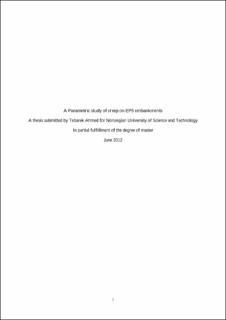| dc.description.abstract | Expanded polystyrene (EPS) has been grown as one of the leading polymers which is used in small strain geotechnical applications such as light weight fill embankments. In design of such embankments, EPS should be able to fulfill major design criterias of which assessment of creep is the most important aspect. Therefore, the main aim of this study was to have a parametric study of creep on EPS embankments. Literature reviews on EPS material has showed scatter of results mainly on mechanical parameters. Inconsistent laboratory testing procedures, specimen variation and interpretation of results are mentioned as a reason for the cause of parameter variation. To evaluate the parameters of EPS, two basic tests have been used in this study- short term loading tests as well as long term loading tests. Short term loading tests are carried out to evaluate the compressive strength and the stiffness parameters of EPS under different specimens and testing procedures while long term loading of EPS is analyzed based total deformation results obtained under 30Kpa constant loading of the specimens for 5 consecutive days. In this study, three different sized (50mm, 100mm and 150mm) cubic samples, three different shaped ( cubic, cylinder and disc) samples, three different loading rates (5mm/min, 3mm/min and 1mm/min) and four specimen temperatures (-20, -10, -5 and 20 oC) are used to investigate parameters of EPS. Results suggest that stiffness of the polymer increases as sample size increases and the same response in increase of stiffness and compressive strength is showed when disc shaped samples, small loading rates and low specimen temperatures are used in general. The long term deformation behavior of EPS for the same set of specimen variation is repeated. Results confirmed the decrease in creep and total deformation when sample sizes increases. Creep test results on small samples tend to overestimate as compared to full scale projects. Disc shaped samples rather give less immediate deformation, however, deformation rate is high enough to give an overestimate along the time scale. In addition, temperature decrease on specimens brought an expected increase in creep. Finite element simulation of EPS geofoam are evaluated using hardening and soft soil models in PLAXIS 2D. EPS parameters calibrated using HS-model gives a practical fit compared with laboratory results and similar trends in long term deformation of EPS embankments are achieved using SSC model in PLAXIS 2D. A slight tendency of overestimation in stiffness is shown when soil models are used. Study regarding creep modeling of EPS embankments is discussed. Empirical equations (Findley equation), equations using isochronous stress-strain curves, sherby-dorn plots and mechanical creep models are studied. Equations developed using creep test results obtained by full scale laboratory test on EPS embankment is used for further discussion. Practical estimation of total deformation was possible up on results found. | en_US |

